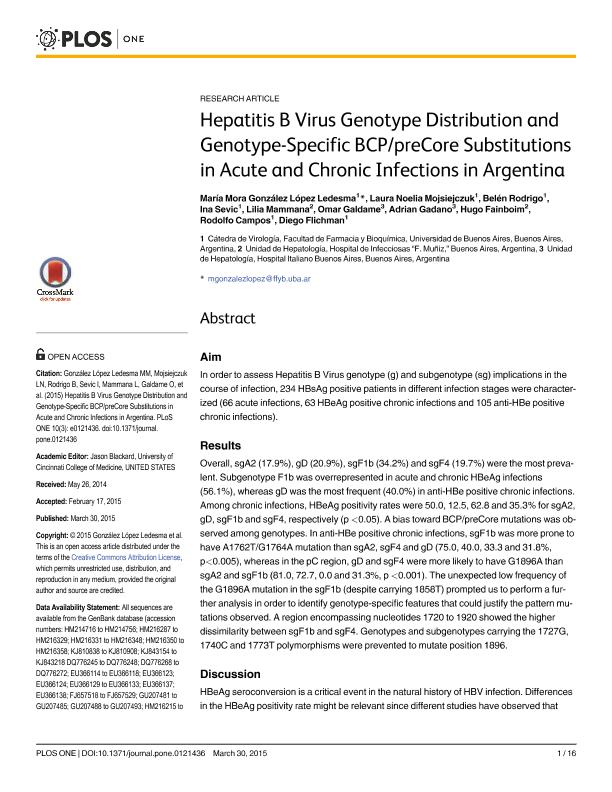Mostrar el registro sencillo del ítem
dc.contributor.author
González López Ledesma, María Mora

dc.contributor.author
Mojsiejczuk, Laura Noelia

dc.contributor.author
Rodrigo, Maria Belen

dc.contributor.author
Sevic, Ina

dc.contributor.author
Mammana, Lilia
dc.contributor.author
Galdame, Omar

dc.contributor.author
Gadano, Adrián Carlos

dc.contributor.author
Fainboim, Hugo

dc.contributor.author
Campos, Rodolfo Hector

dc.contributor.author
Flichman, Diego Martin

dc.date.available
2018-03-20T16:22:14Z
dc.date.issued
2015-03
dc.identifier.citation
González López Ledesma, María Mora; Mojsiejczuk, Laura Noelia; Rodrigo, Maria Belen; Sevic, Ina; Mammana, Lilia; et al.; Hepatitis B Virus Genotype Distribution and Genotype-Specific BCP/preCore Substitutions in Acute and Chronic Infections in Argentina; Public Library of Science; Plos One; 10; 3; 3-2015; 1-16; e0121436
dc.identifier.issn
1932-6203
dc.identifier.uri
http://hdl.handle.net/11336/39358
dc.description.abstract
AIM: In order to assess Hepatitis B Virus genotype (g) and subgenotype (sg) implications in the course of infection, 234 HBsAg positive patients in different infection stages were characterized (66 acute infections, 63 HBeAg positive chronic infections and 105 anti-HBe positive chronic infections). RESULTS: Overall, sgA2 (17.9%), gD (20.9%), sgF1b (34.2%) and sgF4 (19.7%) were the most prevalent. Subgenotype F1b was overrepresented in acute and chronic HBeAg infections (56.1%), whereas gD was the most frequent (40.0%) in anti-HBe positive chronic infections. Among chronic infections, HBeAg positivity rates were 50.0, 12.5, 62.8 and 35.3% for sgA2, gD, sgF1b and sgF4, respectively (p <0.05). A bias toward BCP/preCore mutations was observed among genotypes. In anti-HBe positive chronic infections, sgF1b was more prone to have A1762T/G1764A mutation than sgA2, sgF4 and gD (75.0, 40.0, 33.3 and 31.8%, p<0.005), whereas in the pC region, gD and sgF4 were more likely to have G1896A than sgA2 and sgF1b (81.0, 72.7, 0.0 and 31.3%, p <0.001). The unexpected low frequency of the G1896A mutation in the sgF1b (despite carrying 1858T) prompted us to perform a further analysis in order to identify genotype-specific features that could justify the pattern mutations observed. A region encompassing nucleotides 1720 to 1920 showed the higher dissimilarity between sgF1b and sgF4. Genotypes and subgenotypes carrying the 1727G, 1740C and 1773T polymorphisms were prevented to mutate position 1896. DISCUSSION: HBeAg seroconversion is a critical event in the natural history of HBV infection. Differences in the HBeAg positivity rate might be relevant since different studies have observed that delayed HBeAg seroconversion is associated with a more severe clinical course of infection, highlighting the critical role that genotypes/subgenotypes might play in the progression of HBV infection. Polymorphisms in the regions 1720 to 1920 could be involved in the molecular mechanisms underlying seroconversion of each genotype/subgenotype.
dc.format
application/pdf
dc.language.iso
eng
dc.publisher
Public Library of Science

dc.rights
info:eu-repo/semantics/openAccess
dc.rights.uri
https://creativecommons.org/licenses/by/2.5/ar/
dc.subject
Hepatitis B Virus
dc.subject
Acute Infections
dc.subject
Chronic Infections
dc.subject.classification
Otras Ciencias Biológicas

dc.subject.classification
Ciencias Biológicas

dc.subject.classification
CIENCIAS NATURALES Y EXACTAS

dc.title
Hepatitis B Virus Genotype Distribution and Genotype-Specific BCP/preCore Substitutions in Acute and Chronic Infections in Argentina
dc.type
info:eu-repo/semantics/article
dc.type
info:ar-repo/semantics/artículo
dc.type
info:eu-repo/semantics/publishedVersion
dc.date.updated
2018-03-13T13:56:13Z
dc.journal.volume
10
dc.journal.number
3
dc.journal.pagination
1-16; e0121436
dc.journal.pais
Estados Unidos

dc.journal.ciudad
San Francisco
dc.description.fil
Fil: González López Ledesma, María Mora. Universidad de Buenos Aires. Facultad de Farmacia y Bioquímica. Departamento de Microbiología, Inmunología y Biotecnología. Cátedra de Virología; Argentina. Consejo Nacional de Investigaciones Científicas y Técnicas. Oficina de Coordinación Administrativa Houssay; Argentina
dc.description.fil
Fil: Mojsiejczuk, Laura Noelia. Universidad de Buenos Aires. Facultad de Farmacia y Bioquímica. Departamento de Microbiología, Inmunología y Biotecnología. Cátedra de Virología; Argentina. Consejo Nacional de Investigaciones Científicas y Técnicas. Oficina de Coordinación Administrativa Houssay; Argentina
dc.description.fil
Fil: Rodrigo, Maria Belen. Universidad de Buenos Aires. Facultad de Farmacia y Bioquímica. Departamento de Microbiología, Inmunología y Biotecnología. Cátedra de Virología; Argentina
dc.description.fil
Fil: Sevic, Ina. Universidad de Buenos Aires. Facultad de Farmacia y Bioquímica. Departamento de Microbiología, Inmunología y Biotecnología. Cátedra de Virología; Argentina. Consejo Nacional de Investigaciones Científicas y Técnicas. Oficina de Coordinación Administrativa Houssay; Argentina
dc.description.fil
Fil: Mammana, Lilia. Gobierno de la Ciudad de Buenos Aires. Hospital de Infecciosas "Dr. Francisco Javier Muñiz"; Argentina
dc.description.fil
Fil: Galdame, Omar. Hospital Italiano; Argentina
dc.description.fil
Fil: Gadano, Adrián Carlos. Hospital Italiano; Argentina
dc.description.fil
Fil: Fainboim, Hugo. Hospital Italiano; Argentina
dc.description.fil
Fil: Campos, Rodolfo Hector. Consejo Nacional de Investigaciones Científicas y Técnicas. Oficina de Coordinación Administrativa Houssay; Argentina. Universidad de Buenos Aires. Facultad de Farmacia y Bioquímica. Departamento de Microbiología, Inmunología y Biotecnología. Cátedra de Virología; Argentina
dc.description.fil
Fil: Flichman, Diego Martin. Consejo Nacional de Investigaciones Científicas y Técnicas. Oficina de Coordinación Administrativa Houssay; Argentina. Universidad de Buenos Aires. Facultad de Farmacia y Bioquímica. Departamento de Microbiología, Inmunología y Biotecnología. Cátedra de Virología; Argentina
dc.journal.title
Plos One

dc.relation.alternativeid
info:eu-repo/semantics/altIdentifier/url/http://journals.plos.org/plosone/article?id=10.1371/journal.pone.0121436
dc.relation.alternativeid
info:eu-repo/semantics/altIdentifier/doi/http://dx.doi.org/10.1371/journal.pone.0121436
Archivos asociados
